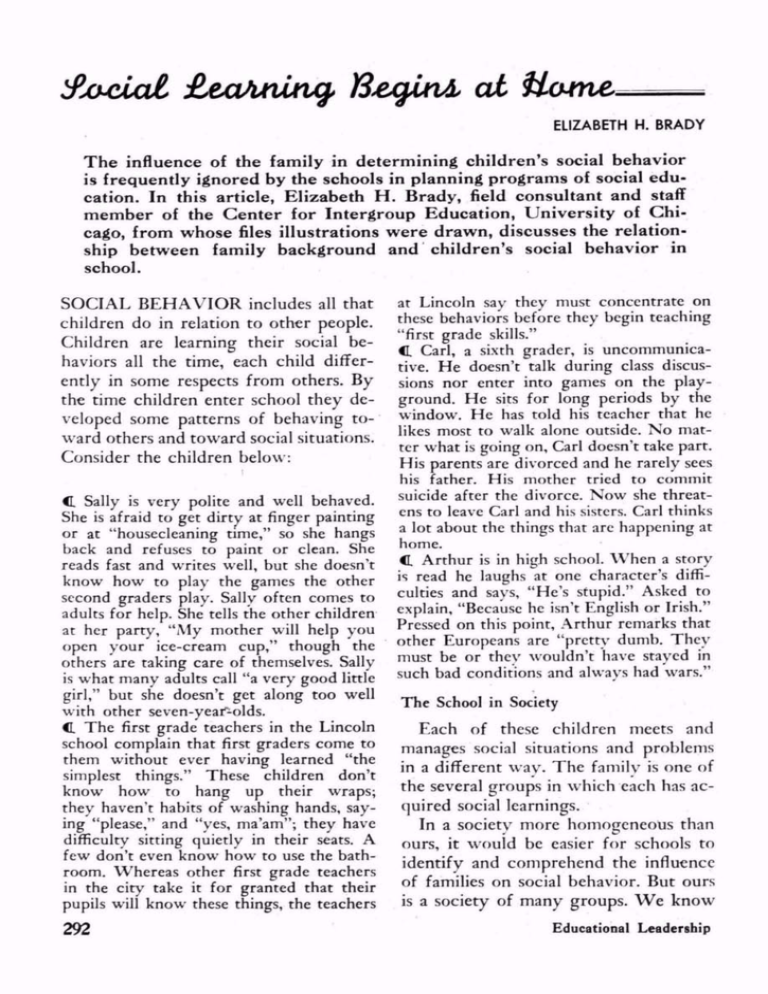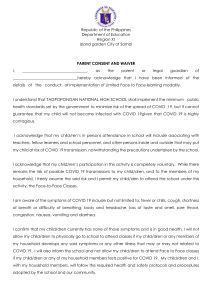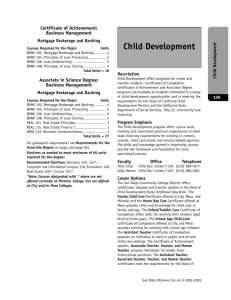
ELIZABETH H. BRADY
The influence of the family in determining children's social behavior
is frequently ignored by the schools in planning programs of social edu
cation. In this article, Elizabeth H. Brady, field consultant and staff
member of the Center for Intergroup Education, University of Chi
cago, from whose files illustrations were drawn, discusses the relation
ship between family background and children's social behavior in
.
.
school.
SOCIAL BEHAVIOR includes all that
children do in relation to other people.
Children are learning their social be
haviors all the time, each child differ
ently in some respects from others. By
the time children enter school they de
veloped some patterns of behaving to
ward others and toward social situations.
Consider the children below:
C Sally is very polite and well behaved.
She is afraid to get dirty at finger painting
or at "housecleaning time," so she hangs
back and refuses to paint or clean. She
reads fast and writes well, but she doesn't
know how to play the games the other
second graders play. Sally often comes to
adults for help. She tells the other children
at her party, "My mother will help you
open your ice-cream cup," though the
others are taking care of themselves. Sally
is what many adults call "a very good little
girl," but she doesn't get along too well
with other seven-year-olds.
C The first grade teachers in the Lincoln
school complain that first graders come to
them without ever having learned "the
simplest things." These children don't
know how to hang up their wraps;
they haven't habits of washing hands, say
ing "please," and "yes, ma'am"; they have
difficulty sitting quietly in their seats. A
few don't even know how to use the bath
room. Whereas other first grade teachers
in the city take it for granted that their
pupils will know these things, the teachers
292
at Lincoln say they must concentrate on
these behaviors before they begin teaching
"first grade skills."
C. Carl, a sixth grader, is uncommunica
tive. He doesn't talk during class discus
sions nor enter into games on the play
ground. He sits for long periods by the
window. He has told his teacher that he
likes most to walk alone outside. No mat
ter what is going on, Carl doesn't take part.
His parents are divorced and he rarely sees
his father. His mother tried to commit
suicide after the divorce. Now she threat
ens to leave Carl and his sisters. Carl thinks
a lot about the things that arc happening at
home.
C. Arthur is in high school. When a story
is read he laughs at one character's diffi
culties and says, "He's stupid." Asked to
explain, "Because he isn't English or Irish."
Pressed on this point, Arthur remarks that
other Europeans are "pretty dumb. They
must be or they wouldn't have stayed in
such bad conditions and always had wars."
The School in Society
>
Each of these children meets and
manages social situations and problems
in a different way. The family is one of
the several groups in which each has ac
quired social learnings.
In a society more homogeneous than
ours, it would be easier for schools to
identify and comprehend the influence
of families on social behavior. But ours
is a society of many groups. We know
Educational Leadership
that people learn the culture pattern of
their group and that each of the multiple
groups in our society has some peculiar
cultural characteristics. Social anthro
pologists and sociologists report that the
majority of teachers come from middleclass families and embody the beliefs,
values, habits, and concepts of the mid
dle class, while the majority of chil
dren two-thirds or more come from
families whose backgrounds differ from
the teachers' because of socio-economic,
ethnic, and racial factors. This means
that teachers cannot accurately predict
from their own experience what children
have learned. Since each of us tends to
accept his group pattern as right, teach
ers are more apt to criticize children's
social behaviors and consider them bad
than to recognize them as behaviors
learned in a context unfamiliar to teach
ers.
Families have had a hand in deter
mining social behaviors long before the
child reaches school, but schools fre
quently fail to find out what the child's
previous socializing experiences have
been. Families influence social behavior
by what they teach, directly and indi
rectly, consciously and unconsciously:
Arthur may have heard remarks about
Central Furopeans at home; Sally may
have been rewarded more for good
grades than for doing things for her
self. Therefore, schools need to know
what children have learned in their fami
lies.
Families also influence social behavior
by what they fail to teach: the Lincoln
first graders are ill equipped to meet the
school's expectations because they have
not been taught certain behaviors at
home: Arthur has learned to relate
stupidity to nationality, but he has not
February 1950
learned that many factors determine
what happens to people. Schools must
therefore identify the limitations homes
have set. Events in the family and feel
ings and interpretations of these events
which the child makes influence his so
cial behavior outside the family: Carl
thinks about his family situation when
he might be entering into school activi
ties. Schools need to be aware of what
is happening to children in their homes.
Children Learn from Families
It is rather easy for teachers to dis
cover whether children have acquired
or failed to acquire a certain set of man
ners and skills. Because they can see
these obvious behaviors they may miss
more subtle social learnings which af
fect behavior.
Children learn ways to express feel
ings how to show anger, friendliness,
or sadness. They learn from imitating a
parent, or from the punishment or ap
proval a parent gives them. They learn a
set of values what is good or bad, im
portant or unimportant, and meanings
for words like "good," "bad," "coop
erative." One child learns that to be
good is to get high grades so parents can
be proud; another learns that to be good
means to keep quiet and not bother any
one at home. One child learns that you
should be polite to others and conform
to their wishes; another, that you
shouldn't let anyone get ahead of you.
Children learn ways of relating them
selves to others; how to get what they
want by wheedling or by doing it them
selves; how to play with other children;
and how to speak to adults. They ac
quire concepts and feelings by which
they pattern their behavior in social sit
uations. Some of these concepts are
293
about themselves "I can do it," or "It's
too hard for me; I'd never be able to."
Some have to do with their picture of
their community and society: "The
people who live west of Prairie are
dumb and you shouldn't go around with
them," and "The swells run everything
at the high school. They don't want
you in their clubs and you'd be smart
not to try to get in." Some have to do
with their attitudes toward school:
"You have to do well so you can go
East to college like your brother," and
"Nobody in that school knows any
thing that's important. They'd never
give a kid from our neighborhood a
break or a good grade anyway." Not
all of these things are learned directly
in families, though some are.
Families Limit Social Learnings
Just as every family setting fosters
social learning, so every family setting
inevitably limits social learning. It limits,
obviously, by what it fails to teach.
Frequently teachers comment, "But that
is something the home should teach!"
Usually this comment refers to some
thing teachers, because of their own
backgrounds, set store by how to be
polite, to keep clean, to speak "prop
erly," to hold certain values. Yet par
ticular homes are quite unable to teach
those behaviors which are part of neither
the pattern of living nor the values of
that home. Intense awareness of these
omissions may blind teachers to the so
cial behaviors children have learned,
such as independence in taking care of
themselves, knowledge of many places
in a community and how to behave
there how to behave, not in the sense
of politeness, but to handle the business
connected with that place, such as shop294
ping at the grocery, using the com
munity center, holding a job.
On the other hand, gaps in social
learning are less obvious to teachers
when children have mastered the be
haviors teachers value. Not every second
grade teacher will be as concerned as
Sally's was over her failure to get along
with other children and her lack of initi
ative in non-academic areas, which
showed limitations in social learning.
All homes are limited in another sense.
By transmitting a particular pattern,
homes tend to exclude, even to devalue,
other patterns. If Arthur's family has
encouraged and rewarded initiative in
making money, in getting ahead, in
achieving social status, Arthur is apt to
think there is something wrong with
people who do not do these things. Chil
dren who learn their own pattern of
family life may think there is something
odd about families who are different:
where there are many children, where
the mother works, or where more time
is spent on having fun than on getting
ahead. They may act toward people
from such families as though there were
something wrong with them. Schools
need to identify these limitations, but it
is not always easy for them to do so.
A junior high school teacher was re
porting to a curriculum committee the
content of students' papers which told
about their families. She concluded her
summary, "It's apparent that these chil
dren already have a very good view of
family life. I decided after reading these
that we just don't need to read stories
about families, because they already
have a very good attitude about what
families should be like." The purpose of
her analysis was to identify the students'
present concepts of family life and to
Educational Leadership
infer from these what extensions of con
cepts about the nature of families should
be provided. The children's accounts
matched the teacher's own view of
proper family life, and she was unable,
without further study, to see the neces
sity of any extension or revision of their
concepts and attitudes, although the
families they pictured showed a narrow
view indeed. There was equal congru
ence in regard to other matters between
the concepts and attitudes of these stu
dents and those of their teacher, so it
was difficult for her to spot where their
social learning was deficient for life in
a society of many social patterns.
Although families are not well
equipped to provide the social learnings
children need to get along with others
in a highly diverse society, public
schools are. With a variety of experi
ences represented among the children
who attend, and freedom to create sit
uations which can increase the range of
social learnings, schools can supplement
what homes teach and help free children
from the limitations of a particular fam
ily or cultural group. But first, schools
need to know which limitations exist.
Children Carry Concerns with Them
A child is not one person at home and
another at school. He does not slough
off when he enters school what has hap
pened to him at home, but carries with
him concerns and interests and feelings
about events in his family. Thus hap
penings in family life, as well as what is
taught there, affect children's social be
havior.
Many children are quite successful at
burying or skillfully concealing their
family and personal concerns while they
are at school. Often they are forced to
February 1950
do so, inasmuch as no time or attention
is allotted for consideration of life out
side the school. Many children are not
so successful. The events at home pre
occupy their thought and energies and
distract them from the situation at hand.
Children carry to school anxieties de
rived in the family context. They hear
about parents' worries at home about
rent or housing or jobs or health and
they absorb them. A child writes, "At
home I have worries. My mother and
father are both different from each other
and are going to separate and I love
them both, but I don't know which one
to go with when they separate." A
child busy trying to solve a problem
like this may handle school situations
with difficulty. The urgency of dealing
with present emergencies at home is fre
quently far greater than the urgency of
school tasks.
Pressures of expectations also carry
over. "I want my parents to be proud
of me. I don't think I am capable of
coming up to their expectations," writes
a ninth grader. Lack of awareness of
such pressures may lead teachers to in
crease the amount of school work, on
the assumption that "these children
haven't enough to keep them busy."
Disagreements are upsetting: "Relatives
try to interfere with problems which
are no concern to them. My family
argues over my education. Mv parents
think I would be better off if I quit
school and went to work. I disagree.
But I don't know what I should do."
It is not only anxieties, problems, and
worries which occupy children; they
think of happy things too, of course.
Schools may be unready to deal with the
former; they may think that the latter do
not "belong in school." Many teachers
295
find it impossible to imagine the prob
lems, tensions in relationships, worries,
and fears which students, even very
young children, are forced to deal with.
We therefore fail to provide for them;
or, fearful of not handling them ade
quately, the school rules out considera
tion of these problems as "too personal
for school" and at the same time dis
counts their effects.
Not only are children preoccupied
with out-of-school events but children
form, in relation to those events, con
cepts of their own adequacy to deal
with any problems. Children who have
been blamed or who blame themselves
for the ways problems or conflicts at
home turned out are handicapped by
their own doubts and fears when they
tackle new problems at school. Chil
dren who have gained confidence in
their own ability to get along with peo
ple will attempt new associations with
assurance. The actual abilities of chil
dren have less to do with their be
havior than their feelings about their
own abilities.
Because it is time consuming to keep
track of these aspects of children's lives,
we often neglect to find out what chil
dren's "outside" lives are like, what they
are experiencing there, how many and
how difficult are the tasks they face.
Nevertheless, it is worthwhile to allow
for the informal chats, papers written
about feelings and personal concerns,
the opportunity to talk about things that
happen to people even at the expense of
other aspects of the program. By these
means teachers obtain glimpses of those
areas of living which affect social be
havior and social learning in school.
When such inquiry is neglected, the so
cial learnings the school attempts to pro
vide often badly miss fire.
At present we know that children
have learned social behavior, but not
precisely li-hat they have learned. We
know their lives are complicated by
many even's and concerns, but not
which ones and how. Each teacher must
try to find answers to these questions as
she plans learning experiences for her
students.
ASCD Meeting in Atlantic City
February 26, 1950
9:30 AM-3:30 PM
Chalfonte-Haddon
Hall
To be held in conjunction
with annual AASA meeting
Nine Study Groups
Two General Sessions
Leadership in Curriculum Planning, V irgil Rogers, Superintendent,
Battle Creek Public Schools, Michigan
Administrative Provisions for Curriculum Improvement, Hoi 1 is Gaswell, Dean, Teachers College, Columbia University, N.Y.
For further information, write to: A SCD, 1201 i6th Street, N.\V., Washing
ton 6, D.C.
296
Educational Leadership
Copyright © 1950 by the Association for Supervision and Curriculum
Development. All rights reserved.








